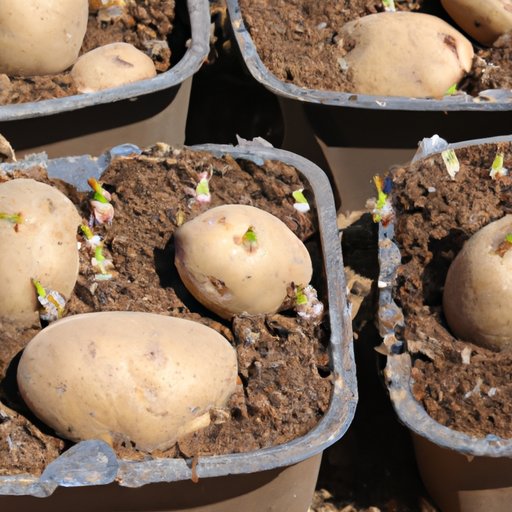I. Introduction
If you’re interested in learning how to plant potatoes, you’ve come to the right place. Growing potatoes is both fun and rewarding, and with the right knowledge and techniques, it’s a relatively easy process. In this article, we will guide you through the entire process of planting potatoes, from preparing the soil to harvesting your crops. We will also discuss container gardening, companion planting, soil types, seasonal planting, and troubleshooting common problems you might encounter along the way.
II. Step-by-Step Guide to Planting Potatoes
The first step in planting potatoes is to choose the right type of potato variety. Russet, red, or yellow potatoes are good options for beginners. Once you have chosen the variety, it’s essential to prepare the soil by tilling, adding compost, and testing the pH level. The ideal pH level for potatoes is between 5.0 and 6.0, and the soil should be well-drained. When planting, ensure you space your potatoes about 12 inches apart and four inches deep in ridges.
Watering is essential in the early stages, and it’s important to keep the soil moist but not saturated. Once the plants start to grow, it’s vital to keep the soil moist but not overly wet. Potatoes are typically ready for harvest when the leaves above the plant start to yellow and fall off. The process usually takes about three to four months.
III. Container Gardening for Potatoes
If you don’t have enough outdoor space to plant potatoes directly in the ground, don’t worry. Container gardening is an excellent alternative method for growing potatoes. The first step is to choose the right container, which should be at least 2 feet deep with adequate drainage. When preparing the soil, ensure you use a high-quality potting mix and add some amendments to meet the nutritional requirements of your plants. When planting, ensure you space your potatoes about six inches apart and cover them with soil
Watering is critical in container gardening, and it’s vital to keep the soil moist but not overly wet. You must also provide enough light for your potato plants by placing them in a sunny location. The benefits of container gardening for potatoes include a higher yield per square foot of soil, more manageable pest control, and easy harvesting. However, the downside is that you will need to water your plants frequently.
IV. Companion Planting with Potatoes
Companion planting is the practice of planting different crops within the same space. It’s a great way to boost the yield of your potato plants and to control pests and diseases. When planting potatoes, some good companion plants include beans, corn, Brussels sprouts, and cabbage. These plants help to repel harmful pests and diseases, provide necessary nutrients, and help maintain soil moisture. The process of companion planting involves planting companion plants with your potato plants, and it’s essential to follow correct planting practices to ensure a successful harvest.
V. Types of Soil for Planting Potatoes
The type of soil you plant your potatoes in significantly impacts their growth and yield. The three main types of soil are sandy, loamy, and clay soil. Sandy soil is well-drained but does not have adequate nutrients. Loamy soil, on the other hand, is a mix of clay, sand, and silt and has excellent water retention. Clay soil tends to retain water and can become overly wet, causing drainage problems. The ideal soil for planting potatoes should be loamy, and its pH level should be between 5.0 and 6.0.
Before planting, it’s important to prepare your soil by tilling, adding organic matter, and amending based on the results of a soil test. Adding organic matter to soil improves its fertility by releasing nutrients, such as nitrogen, phosphorus, and potassium, which are essential for potato growth. Additionally, fertilizer is critical in promoting healthy growth, and it’s essential to choose the right type of fertilizer, such as well-rotted manure or a balanced, all-purpose slow-release fertilizer.
VI. Seasonal Planting for Potatoes
The optimal time to plant potatoes varies according to location and climate. It’s crucial to plant potatoes when the soil is warm enough, and the risk of frost has passed. In most regions, it’s best to plant potatoes in the early spring. However, in places with a mild climate, such as the West Coast, it’s possible to plant potatoes in the fall. When planting in the spring, ensure you are planting after soil temperatures reach between 10 and 15 degrees Celsius. Avoid planting in muddy soil and wait for it to dry up before planting.
VII. Troubleshooting Common Potato Planting Problems
The success of your potato harvest depends on various factors, including soil quality, the right amount of water, and adequate sunlight. However, some issues can arise, such as poor soil quality, improper watering, and pest infestation. To prevent these problems, ensure that you are following the correct planting practices, watering consistently, and applying the right fertilizers and organic amendments. Additionally, control pests and diseases with natural remedies, such as neem oil, diatomaceous earth, or companion planting practices.
VIII. Conclusion
Planting potatoes is a fun and rewarding experience that requires some knowledge and dedication. By following the step-by-step guide provided in this article, you can grow a healthy and fruitful potato garden. Whether you choose to plant in the ground, in containers, or with companion plants, the key is to maintain consistency in providing the right nutrients, water, and sunlight.
